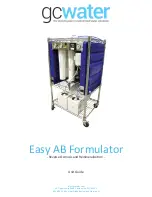
10
3. Plumb a connection from the
COLD
water supply line, ensuring that the feed line is at least
1/2” in diameter. Install a shut off valve on the connection, so that the RO system can by
isolated from the main water supply. Note that the inlet connection to your RO system is 1/2”.
We recommend that you also install a pipe union near the RO to allow easy disconnection
should it be required for maintenance.
4. Make sure the feed water source is a reliable one and will constantly deliver feed water
between 40 psi and 60 psi maximum. Your RO system has been equipped with an
emergency low pressure shut-off, in the event that the line pressure to your RO inlet falls
below 20 psi. This will keep the drive pump from running dry and damage occurring to its
internal components.
3.3. Installing the Drain Line
1. A 3/8” poly tube (minimum) should be used for the drain line.
For systems equipped with
the fast flush option a 1/2” drain line should be installed.
Position the drain line over the
drain and secure it in place. Do not elevate the drain line over 10 feet above the unit. If
connection to a sewer line is necessary, check the local code or a plumbing professional for
guidance and the required parts. Usually a trap with a 2” air gap will suffice.
2.
DO NOT
use a residential septic field for receiving the RO waste from VectaMaxx™ RSR
systems. If used to 24-hour capacity, these systems (depending on the model and settings)
will produce between 763 to 3456 USG (2880 to 12960 liters) per day of wastewater and will
waterlog septic beds.
The amount of waste produced by your system is determined by a fixed, drain line flow control
(DLFC) that has been factory-installed. Do not attempt to restrict or alter the rate of waste
low as this will cause premature membrane failure or loss of permeate production.
3.4. Installing the Filter Cartridge and Membrane (s)
1. Remove the filter housing by turning counter-clockwise with the housing wrench supplied.
Remove all protective wrapping from the 5-micron filter cartridge. Insert the 5-micron white
sediment filter in the housing and reassemble. The housing is seated with o-rings – DO NOT
OVERTIGHTEN – 1/4 turn or less after hand tight is usually sufficient.
Skip (2.) below if the factory has pre-loaded your membrane elements.
2. Remove the wrapping from the membrane element(s). Lightly lubricate the membrane brine
seal and all o-rings located in the membrane housing caps with a good quality, silicone o-
ring lubricant (do not use petroleum-based lubricants). Disconnect the connections on the
membrane housing’s top end cap. Remove the end cap from the membrane housing by
loosening the band clamp nuts and bolts. The membrane housing is mounted vertically on
the system’s stand. See Figure 1. Insert the membrane element into the housing, so that the
brine seal of the membrane will seat at the inlet side of the membrane housing (this is
indicated by the direction of flow label on the housing). See
!
ALWAYS MAINTAIN OR INSTALL A 2” AIR GAP ON ALL DRAIN LINES TO
PREVENT SEWAGE BACK-SIPHONAGE.












































